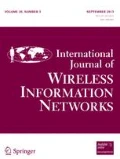Next generation embedded systems will be composed of large numbers of heterogeneous devices. These will typically be resource-constrained (such as sensor motes), will use different operating systems, and will be connected through different types of network interfaces. Additionally, they may be mobile and/or form ad-hoc networks with their peers, and will need to be adaptive to changing conditions based on context-awareness. Our focus in this paper is on the provision of a middleware framework for such system environments. Our approach is based on a small and efficient ‘middleware kernel’ which supports highly modularised and customisable component-based middleware services that can be tailored for specific embedded environments, and are runtime reconfigurable to support adaptivity. These services are primarily communications-related but also address a range of other concerns including service discovery and logical mobility. In the paper we provide an overview of our approach, focusing in detail on both the middleware kernel and the services. We also discuss an application scenario in which we are currently applying and evaluating our middleware approach.










Similar content being viewed by others
Notes
Apart from these, additional components can be optionally included to extend the overlay’s behaviour, e.g., a network QoS measurement component.
Note that Figure 10 presents the framework as an object-oriented one. In implementations in which classes and objects are not available, other constructs (such as dynamic libraries) are used.
References
Szyperski C.(1999) Component Software: Beyond Object-Oriented Programming. Addison-Wesley
Object Management Group, UML 2.0 OCL specification. http://www.omg.org/docs/ptc/03-10-14.pdf
Object Management Group, OMG IDL specification. http://www.omg.org/technology/documents/idl2x_spec_catalog.htm
S. Zachariadis, C. Mascolo, and W. Emmerich. SATIN: A component model for mobile self-organisation. In International Symposium on Distributed Objects and Applications (DOA), Agia Napa, Cyprus, October, 2004. Springer.
Waldo J. (1999) The Jini architecture for network-centric computing. Communications of the ACM, 42(7):76–82
L. Capra, C. Mascolo, S. Zachariadis, and W. Emmerich, Towards a mobile computing middleware: a synergy of reflection and mobile code techniques. In Proc. of the 8th IEEE Workshop on Future Trends of Distributed Computing Systems (FTDCS’2001), pp. 148–154, Bologna, Italy, October, 2001.
Fuggetta A., Picco G., Vigna G. (1998) Understanding code mobility. IEEE Transactions on Software Engineering, 24(5):342–361
G.-C. Roman, A. L. Murphy, and G. P. Picco, A Software Engineering Perspective on Mobility. In A. C. W. Finkelstein (ed.), Future of Software Engineering, ACM Press, 2000.
G.P. Picco, μCode: A Lightweight and Flexible Mobile Code Toolkit. In K. Rothermel and F. Hohl (eds.), Proc. 2nd Int. Workshop on Mobile Agents, LNCS 1477. Springer-Verlag, 1998.
Akyildiz I., Su W., Sankarasubramaniam Y., Cayirci E. (2002) A survey on sensor networks. IEEE Communication Magazine, 40(8):102–114
G. Coulson, G. Blair, P. Grace, A. Joolia, K. Lee, and J. Ueyam, A component model for building systems software. In Proc. IASTED Software Engineering and Applications (SEA’04), Nov, 2004.
H. Cervantes and R. Hall, Autonomous adaptation to dynamic availability using a service-oriented component model. In Proceedings of the 26th International Conference of Software Engineering (ICSE 2004), pp. 614–623, Edinburgh, Scotland, May, 2004, ACM Press.
The OSGi Alliance. The OSGi framework. http://www.osgi.org, 1999.
A. Ferscha, M. Hechinger, R. Mayrhofer, and R. Oberhauser, A light-weight component model for peer-to-peer applications. In 2nd International Workshop on Mobile Distributed Computing. IEEE Computer Society Press, March, 2004.
M. Roman and N. Islam, Dynamically Programmable and Reconfigurable Middleware Services. In Proceedings of Middleware ’04, Toronto, October, 2004.
C. Becker, M. Handte, G. Schiele, and K. Rothermel, PCOM – A component system for pervasive computing. In Proceedings of the 2nd International Conference on Pervasive Computing and Communications, Orlando, Florida, March, 2004.
Y. Weinsberg and I. Ben-Shaul, A programming model and system support for disconnected-aware applications on resource-constrained devices. In Proceedings of the 24th International Conference on Software Engineering, pp. 374–384, May, 2002.
R. S. Hall, D. Heimbigner, and A. L. Wolf, A cooperative approach to support software deployment using the software dock. In Proceedings of the 1999 International Conference on Software Engineering, pp. 174–183. IEEE Computer Society Press/ACM Press, 1999.
J.-P. Fassino, J.-B. Stefani, J. Lawall, and G. Muller, THINK: a software framework for component-based operating system kernels. In 2002 USENIX Annual Technical Conference, pp. 73–86, Monterey, CA, June, 2002, USENIX.
R. Grimm, T. Anderson, B. Bershad, and D. Wetherall, A system architecture for pervasive computing. In Proceedings of the 9th workshop on ACM SIGOPS European workshop, pp. 177–182, ACM Press, 2000.
K. Magoutis, J. Brustoloni, E. Gabber, W. Ng, and A. Silberschatz, Building Appliances out of Reusable Components using Pebble. In Proc. SIGOPS European Workshop, pp. 211–216, Kolding, Denmark, September, 2000, ACM Press.
M. Winter, T. Genbler, A. Christoph, O. Nierstrasz, S. Ducasse, R Wuyts, G. Arevalo, P. Muller, C. Stich, and B. Schonhage. Components for embedded software: the PECOS approach. In Proc. International Conference on Compilers, Architecture, and Synthesis for Embedded Systems (CASES ’02), pp. 19–26, Grenoble, France, 2002, ACM Press.
D. Stewart, R. Volpe, and P. Khosla, Design of Dynamically Reconfigurable Real-Time Software using Port-Based Objects. Technical Report CMU-RI-TR-93-11, Robotics Institute, Carnegie Mellon University, July, 1993.
H. Hansson, M. Akerholm, I. Crnkovic, and M. Torngren, SaveCCM – a component model for safety-critical real-time systems, September, 2004.
van Ommering R., van der Linden F., Kramer J., Magee J. (2000) The Koala component model for consumer electronics software. IEEE Computer, 33(3):78–85
A. Dunkels, B. Groenvall, and T. Voigt, Contiki – a lightweight and flexible operating system for tiny networked sensors. In Proceedings of the First IEEE Workshop on Embedded Networked Sensors, Tampa, Florida, USA, November, 2004.
Acknowledgments
The authors would like to thank their partners in the RUNES Project and to acknowledge the financial support given to this research by the European Commission.
Author information
Authors and Affiliations
Corresponding author
Rights and permissions
About this article
Cite this article
Costa, P., Coulson, G., Mascolo, C. et al. Reconfigurable Component-based Middleware for Networked Embedded Systems. Int J Wireless Inf Networks 14, 149–162 (2007). https://doi.org/10.1007/s10776-007-0057-2
Received:
Accepted:
Published:
Issue Date:
DOI: https://doi.org/10.1007/s10776-007-0057-2




